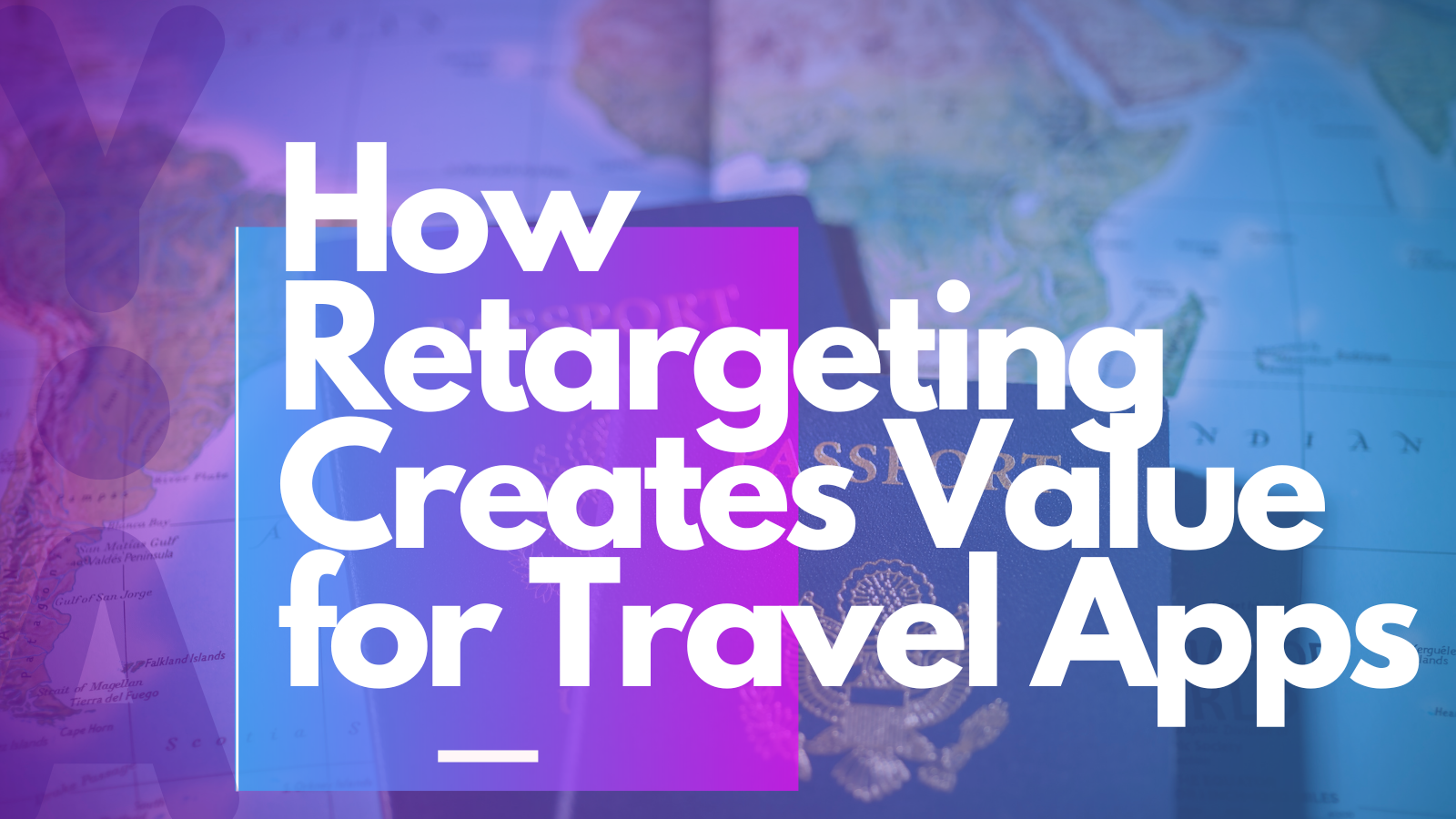The 2022 surge of travel apps
After lackluster performance in 2020 and 2021, travel apps surged in downloads in 2022 — at a higher rate than pre-pandemic levels. By the end of Q1 2021, the U.S. had administered more than 100 million COVID vaccines. Travel apps began rebounding shortly after this period. By Q2 2022, Sensor Tower reported 137 million downloads of travel apps across the U.S. App Store and Google Play stores. This represented an 18% increase from the 116 million downloads driven in Q2 2021. Furthermore, this growth also represented an 18% increase from travel apps’ pre-pandemic levels which were also 116 million quarterly downloads back in Q2 2019.
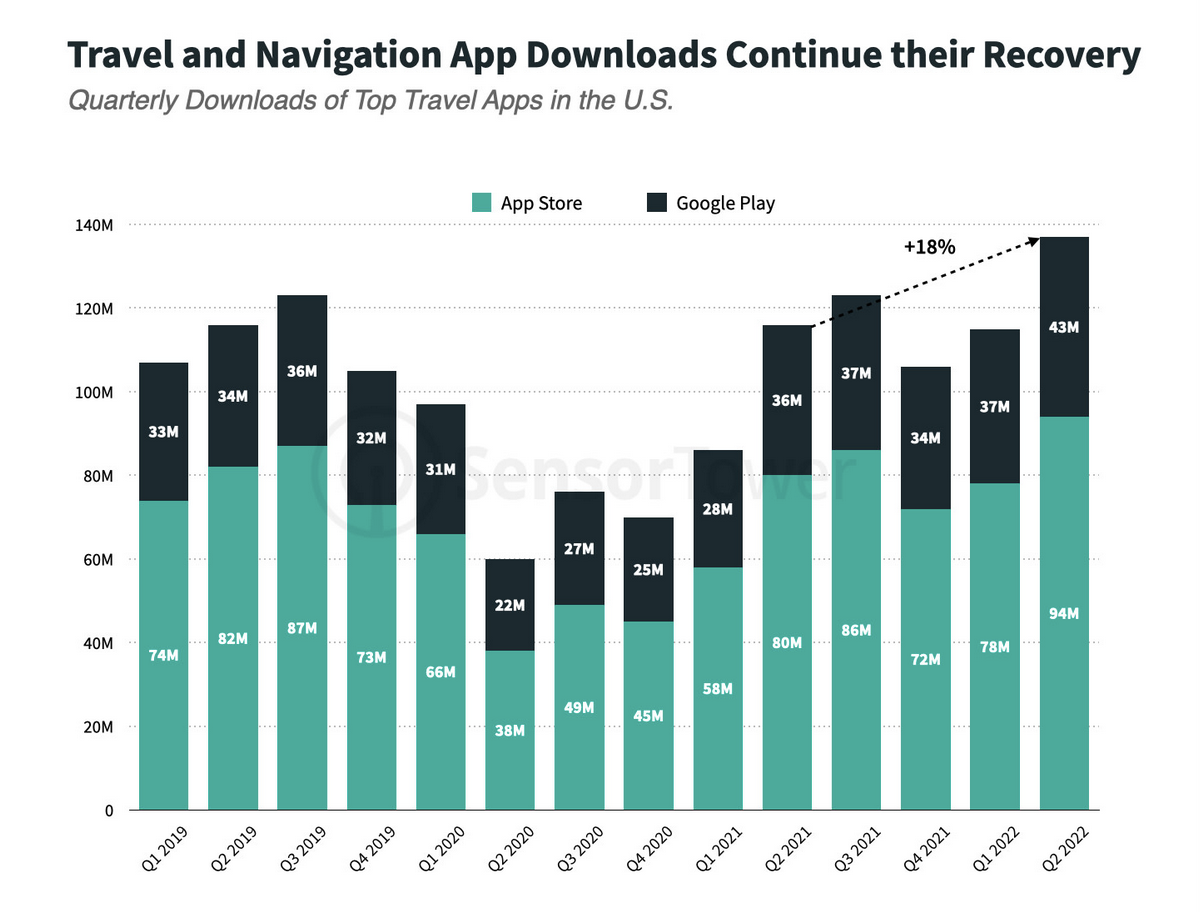
|
Travel booking apps drive growth
Within the long-distance travel app category, travel booking apps drove the greatest growth. Overall, travel booking apps drove 13.6 million downloads in Q2 2022, outpacing airline, vacation rental and hotel brand app categories. Compared to pre-pandemic Q2 2019, travel booking apps grew an impressive 64%.
Travel booking apps were not alone in their growth. Across categories (travel booking, airline, vacation rental and hotel apps), apps grew far beyond pre-pandemic levels. Although the historical leader of the travel app category — airline apps — was bumped down to second place growth-wise in the category, airline apps still increased downloads by 34% compared to Q2 2019. Furthermore, vacation rentals grew 105% compared to pre-pandemic levels and hotel apps by 77%, respectively.
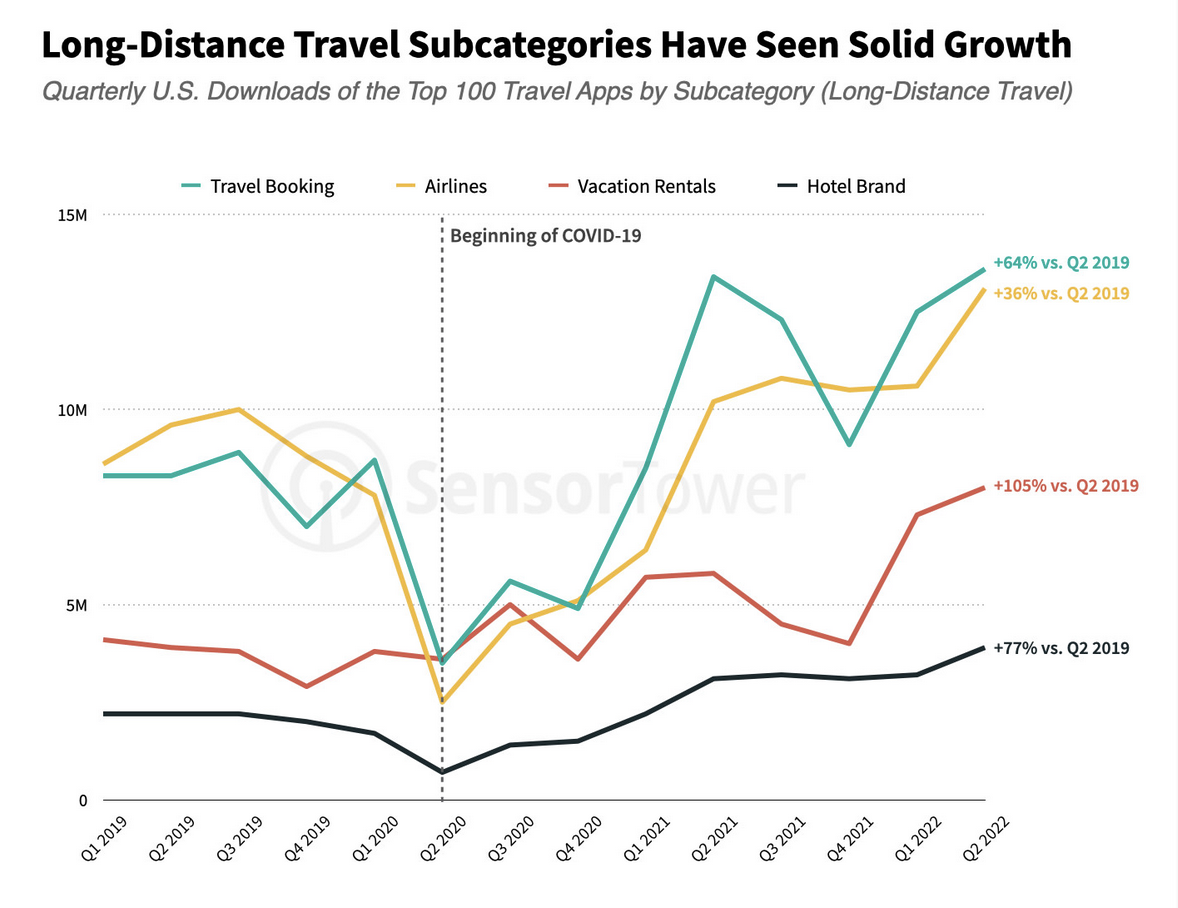
|
When comparing year-over-year growth from Q2 2021, vacation rental apps take the lead compared to other categories. Vacation rental apps grew 38% year-over-year, airline apps grew 28%, hotel apps grew 26% and travel booking apps grew by 1%, respectively.
This indicates that while travel booking apps have driven the most downloads overall, the category has not grown the fastest since the start of the pandemic. Instead, vacation rental apps have seen the greatest growth since the beginning of the pandemic, growing 105% since 2019 and 38% over the last year.
The top long-distance travel apps
According to data from Apptopia, Booking.com was the most downloaded online travel agency (OTA) app in the world in the first half of 2022 with 41 million installs. Following Booking.com was AirBnb with 27 million downloads and Expedia with 12.4 million downloads, respectively.
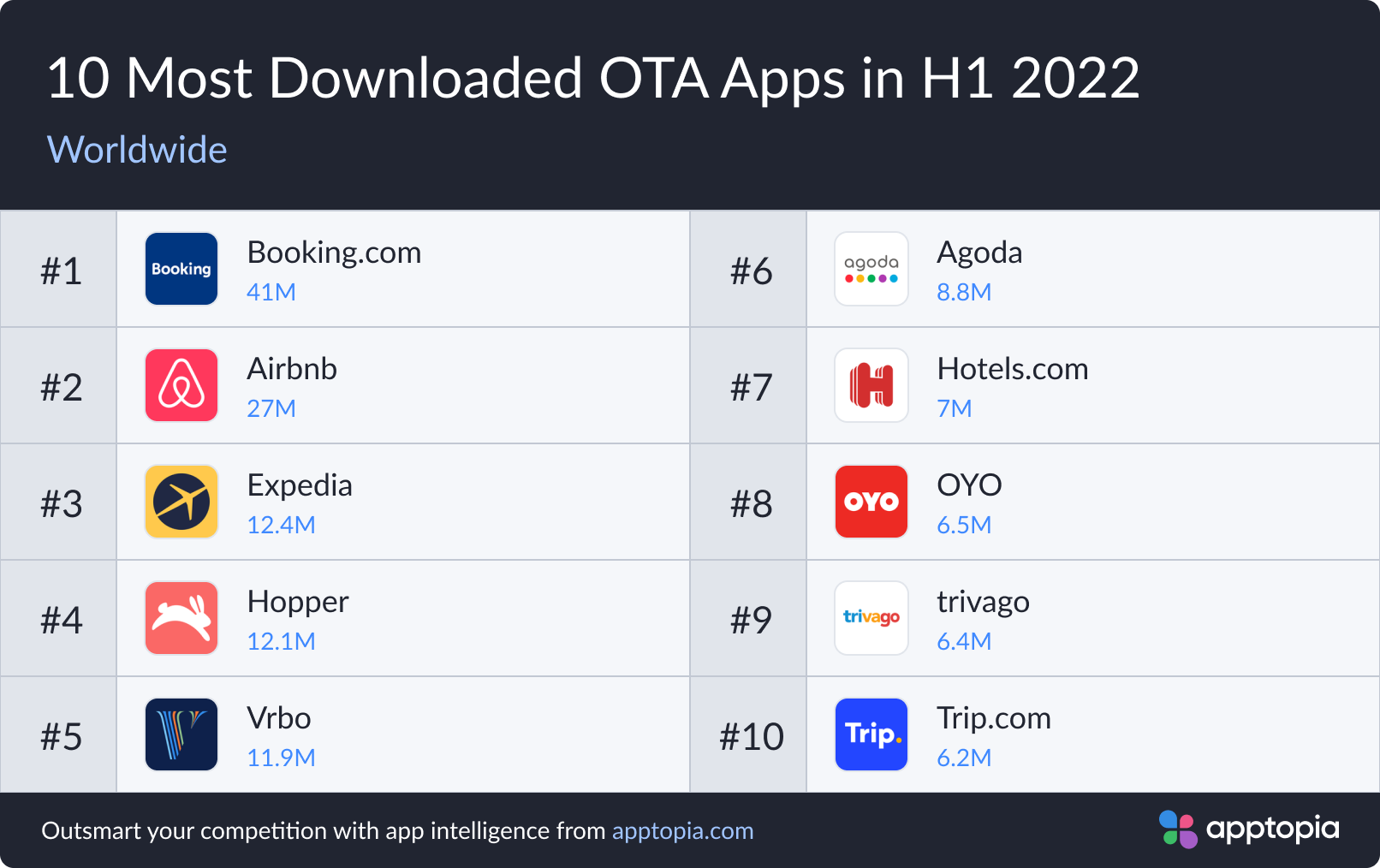
|
In the United States, the top OTA app was VRBO with 10 million downloads; followed closely by Hopper with 8.82 million downloads and Booking.com with 8.79 million downloads, respectively.
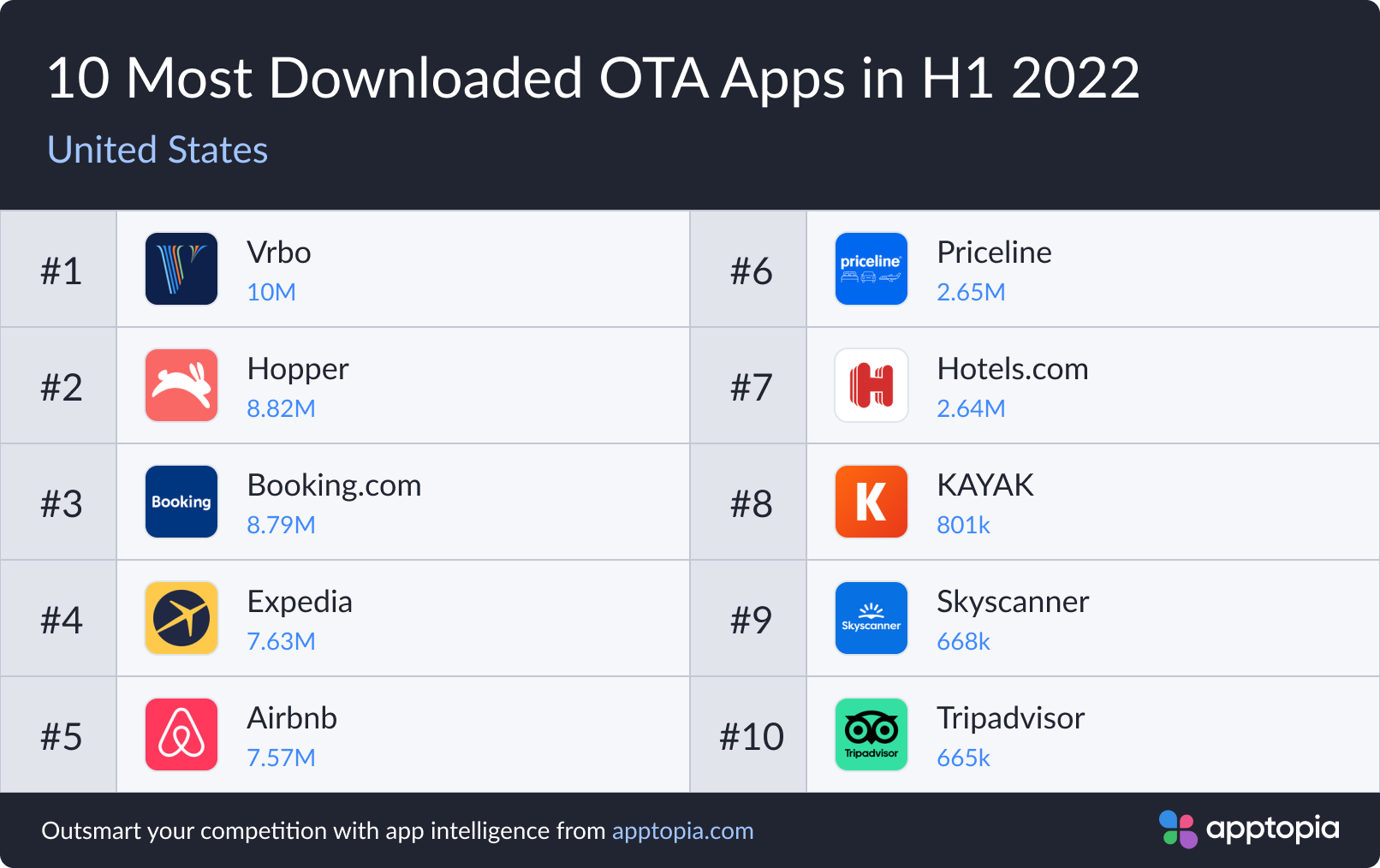
|
According to Apptopia, pent up demand for travel at affordable price points has ratcheted up the competition between OTAs, propelling a focus on mobile growth. This includes AirBnb’s redesign launched in the summer 2022, Booking.com’s prioritization of mobile growth initiatives and reports last summer that Hopper is building a super app.
Retargeting strategies for travel apps
Travel apps might have been successful at growing their audiences since the pandemic, but that doesn’t mean they’re driving revenue at a higher rate compared to pre-pandemic levels. What’s the best way to drive growth that actually leads to greater revenue? Retargeting!
Reactivate high-potential new users
Loads of new users might have downloaded a travel app, but that doesn’t mean they’ve made purchases using the app. Use contextual signals and privacy-compliant first party data to segment users that are most likely to make a purchase. To identify these users, identify behavioral benchmarks that indicate a user is likely to make a purchase. Some example benchmarks could be when a user reaches a certain session length, sets a travel price alert or sends a link to a flight or lodging on your app.
After segmenting specific high-potential user groups, create custom campaign messaging for each that nudges them towards a purchase. Make sure this messaging aligns with lifecycle communications across social and owned channels.
Promote price drops, flash sales, special offers and subscriptions
Don’t let your users drop-off after their trip is over! To inspire continued engagement with your app, use retargeted ads to promote flash sales, special offers and even subscription services or loyalty programs your app might offer. Craft ad creatives that clearly communicate the value of re-opening your app to a user. As mentioned above, this could be highlighting fresh new deals for bookings at or to a certain location. This could also take the form of highlighting the specific amount of money they could save by earning and using points via your loyalty program.
Provide personalized recommendations
Different generations use technology differently. Depending on your user base, create ads that align with a customer’s demographic behavior. According to Oracle, different generations find value from different benefits provided by brands. For example, Millennials find the most in member-only perks like free shipping and personalized experiences. On the other hand, Baby Boomers are more interested in VIP treatment than any other generation. Finally, Gen Z is most likely to find value in milestone rewards.
If possible, create cohorts of different users based on their demographic. Highlight services or products in your app that align with each group’s most desired value-add.
Takeaways
In Q2 2022, travel apps drove 137 billion downloads. This represented an 18% increase from 2019 pre-pandemic levels. Leading this growth were travel booking apps like Hopper and Expedia Group. To drive growth that leads to sustained revenue generation, travel apps should invest in retargeting strategies that inspire continued engagement and loyalty.
- Reactivate high-potential new users: Identify behavioral benchmarks that indicate a user has a high-potential for purchasing in your app. Craft custom campaign messaging that nudges them towards a purchase and make sure this messaging aligns with your lifecycle communications across social and owned channels.
- Promote price drops, flash sales, special offers and subscriptions: clearly communicate the value of re-opening your app to a user by highlighting fresh deals, cost-saving loyalty programs and price drops.
- Provide personalized recommendations: create ads that align with a customer’s demographic behavior.
Turn first time users into long time customers
The most active travel time of the year — Q3 — is just around the corner. Reach out to our team to get your travel app’s retargeting campaigns ready for maximum re-engagement and revenue!




